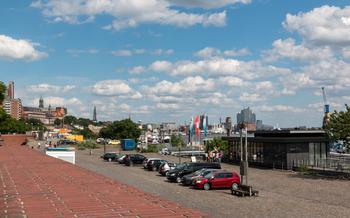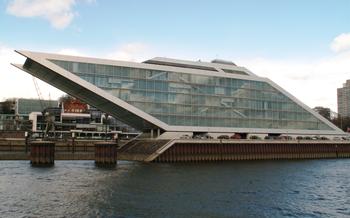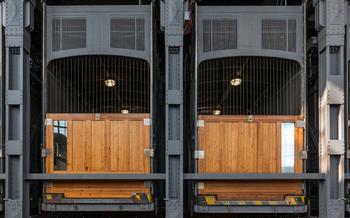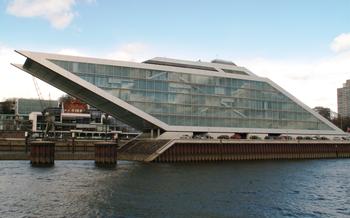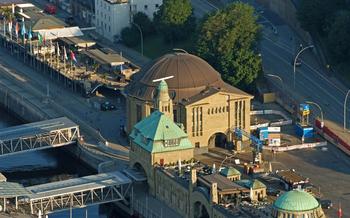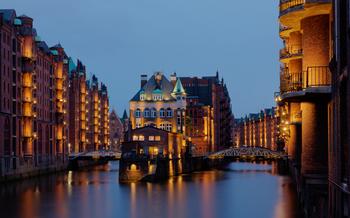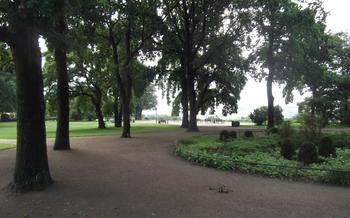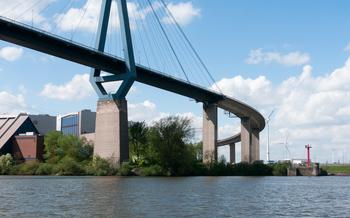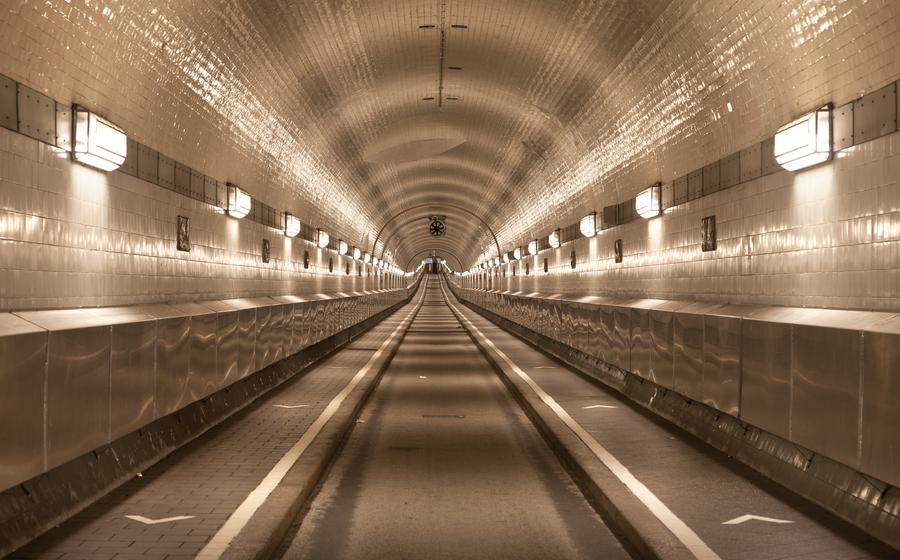
Alter Elbtunnel
- A City Bound to Water
- Engineering Marvel: The Old Elbe Tunnel
- A Walk Through History
- Exploring the Tunnel
- A Photographer's Paradise
- The St. Pauli Piers
- A Culinary Adventure
- Harbor Tours
- The Rickmer Rickmers
- The Elbphilharmonie: A Symphony of Architecture and Acoustics
- The Miniatur Wunderland: A World in Miniature
- The Fish Market
- The Port of Hamburg
- The Reeperbahn
- Insider Tip: Hidden Gems
A City Bound to Water
Hamburg, a city deeply intertwined with water, lies at the heart of Northern Germany, where the Elbe River meets the North Sea. Its unique location has shaped its history, culture, and economy, earning it the title "Gateway to the World." The city's many canals, crisscrossing the urban landscape, and over 2,500 bridges, more than Venice or Amsterdam, have made Hamburg a true "Venice of the North," where water is an integral part of everyday life.
The Elbe River, a lifeline for Hamburg, has been a vital trade route for centuries, connecting the city to the North Sea and beyond. The city's port, one of the largest in Europe, has played a crucial role in Hamburg's rise as a major trading hub and a gateway to the world. The canals, initially built for transportation and flood control, have evolved into scenic waterways, offering unique perspectives of the city's architecture and vibrant waterfront.
Water is not just a geographical feature in Hamburg; it's a cultural touchstone. The city's maritime heritage is celebrated in its museums, festivals, and events. The annual Hamburg Port Anniversary, a week-long extravaganza, is a testament to the city's deep connection to its waterways. With its unique charm and maritime flair, Hamburg invites visitors to explore its watery wonders, from the historic canals and bridges to the mighty Elbe River and beyond.
Engineering Marvel: The Old Elbe Tunnel
In the early 1900s, as Hamburg's population and commerce burgeoned, the need for an efficient way to cross the Elbe River became increasingly pressing. The city's burgeoning maritime industry demanded a reliable connection between the city center and the port facilities on the opposite bank. Conventional bridges, however, were deemed impractical due to the heavy shipping traffic on the river.
Thus, in 1901, construction commenced on a bold and innovative engineering project: the Elbe Tunnel. Designed by the renowned German engineer Franz Andreas Meyer, the tunnel was a marvel of its time. It comprised two parallel wrought-iron tubes, each measuring 426 meters in length and 6 meters in diameter, sunk beneath the riverbed using the innovative shield tunneling method.
The tunnel's construction was a monumental undertaking, involving the excavation of 2 million cubic meters of earth and the placement of over 20,000 cast-iron segments. The project was plagued by numerous challenges, including flooding, ground instability, and the relentless pressure of the river above. Despite these setbacks, the tunnel was completed in 1911, serving as a testament to the ingenuity and perseverance of its creators.
A Walk Through History
The Alter Elbtunnel stands as a testament to Hamburg's rich history and has played a significant role in shaping the city's identity. It was designated as a historical landmark in 1978, recognizing its architectural and cultural importance. During World War II, the tunnel served as a crucial air-raid shelter for Hamburg's citizens, providing refuge from the devastating Allied bombings. Its strategic location and sturdy construction made it an ideal shelter, capable of withstanding the impact of nearby explosions.
After the war, the tunnel underwent extensive repairs and restoration to restore it to its former glory. The city took great care to preserve the tunnel's original features, ensuring that its historical integrity remained intact. Today, the Alter Elbtunnel stands as a reminder of Hamburg's resilience and its ability to overcome adversity. It continues to serve as a vital transportation link, while also attracting visitors who are eager to explore its historical significance.
Exploring the Tunnel
The Alter Elbtunnel is a multi-faceted attraction, and exploring its two levels offers unique perspectives. The upper level is dedicated to pedestrians and cyclists, inviting you to embark on a leisurely stroll or a brisk bike ride. Here, you'll be immersed in the tunnel's distinctive atmosphere, surrounded by its original brickwork and cast-iron elements. The lower level is reserved for vehicles, but you can still catch glimpses of the engineering marvels as cars and buses pass through.
The tunnel's interior is adorned with various exhibits and displays that provide insights into its history, construction, and significance. Interactive panels and informative plaques share fascinating stories and facts about the tunnel, making your journey through it an educational experience as well. Keep an eye out for the scale model of the tunnel, which offers a comprehensive overview of its intricate design and dimensions.
A Photographer's Paradise
The Alter Elbtunnel is a photographer's dream, with its unique lighting and architecture creating a captivating atmosphere. The tunnel's arched brickwork, intricate metalwork, and vintage signage provide a striking backdrop for capturing stunning photos. The play of light and shadow within the tunnel creates dramatic effects, making it an ideal location for both casual and professional photographers.
Photographers can capture the tunnel's grandeur by shooting from various angles and perspectives. The best shots can be obtained by experimenting with different lighting conditions, such as the soft glow of dawn or the warm hues of dusk. Tripods are recommended for long exposure shots, allowing photographers to capture the tunnel's ethereal beauty in all its glory.
For a unique perspective, photographers can venture onto the pedestrian walkway, which offers a close-up view of the tunnel's intricate details. They can capture the reflections of the water on the tunnel walls, creating a mesmerizing effect. Additionally, the tunnel's two entrances, with their distinctive brick facades and arched doorways, provide excellent opportunities for capturing the tunnel's historical charm.
The St. Pauli Piers
The Alter Elbtunnel is located in the vibrant neighborhood of St. Pauli, known for its lively atmosphere and diverse attractions. Just steps away from the tunnel entrance, visitors can immerse themselves in a world of bars, restaurants, shops, and entertainment venues.
The St. Pauli Piers, a prominent landmark in the area, offer a bustling hub of activity. Here, visitors can find a wide array of culinary delights, from traditional German cuisine to international flavors. Whether it's a hearty meal or a refreshing drink, the piers have something to satisfy every palate.
For those seeking a lively nightlife experience, St. Pauli is the place to be. The area is home to numerous bars and clubs, each with its own unique ambiance. From live music venues to dance clubs, there's something for everyone to enjoy.
As the sun sets, the St. Pauli Piers transform into a vibrant hub of entertainment. The streets come alive with music, laughter, and the buzz of conversation. It's the perfect place to soak in the electric atmosphere and experience the vibrant nightlife that Hamburg has to offer.
A Culinary Adventure
Hamburg is a foodie's paradise, offering a diverse culinary scene that caters to every palate. From traditional German cuisine to international flavors, there's something for everyone to savor in this vibrant city.
Local Specialties:
- Labskaus: A hearty dish made with corned beef, potatoes, beetroot, and a fried egg.
- Franzbrötchen: A sweet pastry similar to a croissant, but with a unique flavor and texture.
- Hamburger Pannfisch: Pan-fried fish fillets served with a creamy sauce and potatoes.
- Rote Grütze: A refreshing dessert made with red fruits, such as strawberries, raspberries, and currants, served with custard or vanilla sauce.
Must-Try Restaurants:
- Zur Haxe: A traditional German restaurant known for its crispy pork knuckle and other hearty dishes.
- St. Oberholz Coffee: A trendy café serving delicious coffee, homemade cakes, and brunch options.
- Clouds Heaven's Bar & Kitchen: A rooftop restaurant with stunning views of the city, offering a modern European menu.
- Fischereihafen Restaurant: A seafood restaurant located in the heart of the fish market, serving fresh catches of the day.
Insider Tips:
- Visit the HafenCity: This up-and-coming neighborhood is home to a variety of restaurants, from casual eateries to fine dining establishments, many with outdoor seating overlooking the Elbe River.
- Explore the Altona district: Known for its vibrant food scene, Altona offers a diverse range of restaurants, including international cuisine, vegan options, and street food markets.
- Take a food tour: Several food tours are available in Hamburg, offering a chance to sample local specialties and learn about the city's culinary history.
Harbor Tours
Explore Hamburg's Waterways
Complement your visit to the Alter Elbtunnel with a fascinating harbor tour. Departing from the tunnel area, numerous boat tours offer a unique perspective on Hamburg's maritime heritage. Glide along the Elbe River, passing by iconic landmarks such as the Speicherstadt warehouse district, the HafenCity district, and the Elbphilharmonie concert hall. Marvel at the vast container ships and historical sailing vessels that line the harbor, a testament to Hamburg's enduring role in global trade.
During the tour, knowledgeable guides provide insights into the city's maritime history, pointing out significant landmarks and sharing stories of Hamburg's seafaring past. Learn about the city's role as a major trading hub, its connection to the Hanseatic League, and the challenges it faced as a port city.
For a truly immersive experience, consider taking a boat tour that ventures into the canals of the Speicherstadt. This unique district, with its rows of red-brick warehouses, offers a glimpse into Hamburg's rich trading history. Admire the intricate facades of the buildings, each adorned with gables, turrets, and other architectural details.
Whether you choose a short sightseeing cruise or a more comprehensive tour, a harbor tour is an unforgettable way to experience Hamburg's maritime charm. Embark on a journey through the city's waterways and discover the stories that lie beneath the surface.
The Rickmer Rickmers
Moored near the Alter Elbtunnel, the Rickmer Rickmers is a historic sailing ship that once sailed the world's oceans, carrying exotic spices and other goods. Built in 1896, this three-masted barque is a testament to the ingenuity and craftsmanship of the era.
Step aboard the Rickmer Rickmers and be transported back in time to the days of global exploration and adventure. Explore the ship's decks, cabins, and hold, and learn about its fascinating history. Discover the challenges faced by sailors on these long voyages, and the role that ships like the Rickmer Rickmers played in shaping the global economy.
As you wander through the ship, admire the intricate details and craftsmanship that went into its construction. From the polished brass fittings to the gleaming wooden decks, the Rickmer Rickmers is a true work of art. Don't miss the chance to climb to the crow's nest for a breathtaking view of Hamburg and the Elbe River.
The Rickmer Rickmers is not just a museum ship; it's also a vibrant cultural venue. Throughout the year, the ship hosts a variety of events, including concerts, exhibitions, and workshops. Check the ship's website for upcoming events and plan your visit accordingly.
Whether you're a history buff, a sailing enthusiast, or simply someone who appreciates beautiful ships, the Rickmer Rickmers is a must-visit attraction in Hamburg. So, take a step back in time and experience the romance and adventure of the high seas aboard this magnificent sailing vessel.
The Elbphilharmonie: A Symphony of Architecture and Acoustics
Amidst the bustling harbor district of Hamburg, a striking architectural masterpiece rises from the banks of the Elbe River, captivating the hearts of music enthusiasts and architecture aficionados alike. The Elbphilharmonie, a concert hall of unparalleled grandeur, has transformed the city's skyline, becoming an iconic symbol of Hamburg's cultural vibrancy.
The Elbphilharmonie's journey began in 2007 when construction commenced on the site of a former warehouse. Designed by the renowned Swiss architecture firm Herzog & de Meuron, the building boasts a unique and audacious design that blends the old with the new. The base of the structure, a former cocoa warehouse, has been meticulously preserved, while the shimmering glass façade of the new concert hall crowns the building, resembling a billowing sail catching the wind.
Inside, the Elbphilharmonie houses three concert halls, each meticulously crafted to deliver an exceptional acoustic experience. The Grand Hall, the largest of the three, can accommodate up to 2,100 guests and features a revolutionary vineyard-style seating arrangement that surrounds the stage, creating an intimate and immersive atmosphere for both performers and audience members.
The Elbphilharmonie's acoustics have been the subject of much praise and admiration. Renowned acoustician Yasuhisa Toyota spent countless hours fine-tuning the hall's design, resulting in a space where every note resonates with clarity and precision. Whether it's the delicate plucking of a guitar string or the soaring melodies of a symphony orchestra, the Elbphilharmonie's acoustics elevate every performance to new heights.
Attending a concert at the Elbphilharmonie is an unforgettable experience. The hall's stunning architecture, combined with the world-class acoustics and the caliber of the performances, creates a truly magical atmosphere that transports audiences to another realm. From classical concerts to jazz performances and contemporary music, the Elbphilharmonie's diverse programming caters to a wide range of musical tastes.
In addition to concerts, the Elbphilharmonie also offers guided tours that provide visitors with a fascinating glimpse into the building's history, architecture, and acoustics. Visitors can explore the various concert halls, learn about the innovative construction process, and discover the secrets behind the hall's exceptional sound quality.
Whether you're a seasoned music lover or simply appreciate architectural marvels, the Elbphilharmonie is a must-visit destination in Hamburg. Its unique design, world-class acoustics, and diverse programming have cemented its reputation as one of the leading concert halls in the world. Prepare to be mesmerized as you immerse yourself in the symphony of architecture and acoustics that is the Elbphilharmonie.
The Miniatur Wunderland: A World in Miniature
The Miniatur Wunderland is a must-visit attraction for anyone interested in model railways, intricate craftsmanship, or simply marveling at the wonders of miniature engineering.
Located just a short walk from the Alter Elbtunnel, this remarkable attraction showcases the world's largest model railway, featuring an astonishing level of detail and realism. With over 15,000 meters of track, 1,040 trains, and 260,000 human figures, the Miniatur Wunderland offers a captivating journey through various landscapes, cities, and historical scenes.
The attention to detail in the models is simply breathtaking. From the tiny trees and flowers to the intricate facades of buildings, every element is meticulously crafted to create a sense of authenticity and immersion. The layout includes various sections, such as the Swiss Alps, the Hamburg harbor, and even a miniature version of Las Vegas, each with its own unique charm and storytelling.
The Miniatur Wunderland is not just a visual spectacle; it is also an interactive experience. Visitors can operate certain elements of the layout, such as controlling the trains, turning on lights, and even triggering special effects like erupting volcanoes and thunderstorms. This interactivity adds an extra layer of engagement and makes the experience even more memorable.
Whether you're a railway enthusiast, a lover of miniatures, or simply someone who appreciates exceptional craftsmanship, the Miniatur Wunderland is an attraction that should not be missed. Prepare to be amazed as you journey through this incredible world in miniature, where imagination and precision come together to create a truly unforgettable experience.
The Fish Market
The lively Fish Market is a vibrant and iconic part of Hamburg's cultural identity. Held every Sunday morning in the heart of the city, this bustling market draws locals and tourists alike with its fresh seafood, local delicacies, and lively atmosphere.
The market's origins can be traced back to the 18th century when Hamburg was a major trading hub for fish. Over the years, it has evolved into a vibrant social event where people come to buy, sell, and savor the freshest catch of the day. From plump oysters and succulent lobsters to aromatic smoked eel and glistening herring, the variety of seafood on offer is simply astounding.
Beyond the seafood, the Fish Market is also a culinary haven for those seeking a taste of Hamburg's local cuisine. Try the hearty Labskaus, a traditional dish made with corned beef, potatoes, and beetroot, or indulge in the sweet and flaky Franzbrötchen, a local pastry similar to a croissant.
The atmosphere at the Fish Market is electric, with vendors hawking their wares, live music playing, and the air filled with the sounds of laughter and chatter. It's a place where locals and visitors mingle, sharing stories, and enjoying the unique charm of this beloved market.
Here are some tips for making the most of your visit to the Fish Market:
-
Arrive early: The market is at its busiest between 5 am and 9 am. If you want to avoid the crowds, aim to arrive before 7 am.
-
Bring cash: Most vendors at the market only accept cash, so make sure to come prepared.
-
Dress appropriately: The market can be quite wet and slippery, so wear comfortable shoes and clothing that you don't mind getting a little messy.
-
Be prepared to haggle: Bargaining is a common practice at the Fish Market, so don't be afraid to negotiate prices with the vendors.
-
Enjoy the atmosphere: The Fish Market is an experience in itself, so take your time to soak up the lively atmosphere and enjoy the unique sights and sounds of this iconic Hamburg tradition.
The Port of Hamburg
The Port of Hamburg, situated along the Elbe River and comprising the largest port complex in Germany, is an embodiment of the city's profound maritime heritage. It has played a pivotal role in shaping Hamburg's identity as a global trade hub, a legacy that dates back to the Middle Ages when the city became a member of the Hanseatic League. The port's strategic location at the mouth of the Elbe, a vital waterway connecting the North Sea to Central Europe, has made it a gateway for goods and people from all corners of the world.
Over the centuries, the Port of Hamburg has undergone remarkable transformations, adapting to the ever-evolving demands of global trade. Today, it encompasses an extensive network of terminals, docks, and warehouses, handling a diverse range of cargo, from containers to bulk commodities. The port's infrastructure is a testament to German engineering prowess, with state-of-the-art facilities and equipment ensuring efficient and seamless operations.
The Port of Hamburg not only serves as a vital economic engine for the city and the region but also holds immense historical significance. It bears witness to Hamburg's rise as a maritime power and its enduring resilience in the face of challenges, including the devastating fires and wars that have ravaged the city throughout its history.
Visitors to Hamburg can delve into the port's rich legacy by embarking on guided tours that provide insights into its operations and historical significance. These tours offer a unique perspective on the port's bustling activity, showcasing the intricate ballet of cargo ships, cranes, and trucks that orchestrate the seamless flow of goods.
Whether you're a history buff, an admirer of engineering marvels, or simply curious about the inner workings of a major port, the Port of Hamburg is a must-visit destination that promises an unforgettable experience.
The Reeperbahn
The Reeperbahn, Hamburg's infamous red-light district, is just a stone's throw away from the Alter Elbtunnel. This vibrant and colorful neighborhood is a world of its own, pulsating with life and energy. Stroll along the neon-lit streets and discover a myriad of bars, nightclubs, theaters, and restaurants, each promising a unique and unforgettable experience.
In recent years, the Reeperbahn has undergone a remarkable transformation, evolving from a notorious red-light district into a vibrant and eclectic entertainment hub. While it still retains its seedy charm, the area has become increasingly popular with tourists, locals, and artists, who flock here to enjoy the diverse nightlife offerings.
The Reeperbahn is also home to several cultural landmarks, including the St. Pauli Theater, known for its cutting-edge productions, and the Große Freiheit 36, a legendary music club that has hosted countless iconic artists throughout the years.
Whether you're looking for a wild night out or simply want to soak up the unique atmosphere, the Reeperbahn is a must-visit destination in Hamburg. Just be prepared to embrace its vibrant energy and open-minded spirit.
Insider Tip: Hidden Gems
To truly experience Hamburg like a local, venture off the beaten path and explore the hidden gems surrounding the Alter Elbtunnel. For a quieter and more intimate visit, consider visiting the tunnel early in the morning or during the off-season. Take advantage of this time to capture unique photos without the crowds.
Stroll through the charming Baumwall district, located just a short walk from the tunnel. This historic neighborhood is home to quaint cafes, independent shops, and hidden courtyards, offering a glimpse into Hamburg's rich past.
Don't miss the old warehouses along the Elbe River, which have been transformed into creative spaces, galleries, and unique shops. Explore these hidden gems to discover local artists, vintage treasures, and one-of-a-kind souvenirs.
Immerse yourself in the local culture by visiting the many traditional restaurants and bars in the area. Sample regional delicacies such as Labskaus, a hearty meat and potato dish, or Franzbrötchen, a sweet pastry similar to a croissant. Ask locals for their recommendations to find the best hidden culinary gems.
